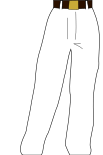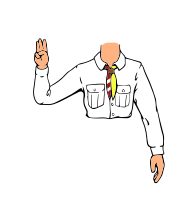Sea Scouting (Boy Scouts of America)
| Sea Scouting | |||
|---|---|---|---|
.png) | |||
| Owner | Boy Scouts of America | ||
| Age range | 13 through 21 years[1] | ||
| Country | United States | ||
| Founded | 1912 | ||
| Founders |
Arthur A. Carey Charles T. Longstreth | ||
| National Commodore | Charles D. Wurster | ||
| National Director | Keith Christopher | ||
| National Boatswain | Rachel West | ||
| |||
|
Website seascout | |||
| |||
Sea Scouting is a program of the Boy Scouts of America for young men and women.[2] Along with Cub Scouting, Boy Scouting, Varsity Scouting, and Venturing, Sea Scouting provides a program for religious, fraternal, educational, and other community organizations to use for character, citizenship, and mental and personal fitness training for youth. As part of this training, Sea Scouts are expected to develop personal religious values, learn the principles of American heritage and government, and acquire skills that will prepare them to become successful adults.
Sea Scouting is the BSA's implementation of the Sea Scout program, initially developed in 1910 by Warington Baden-Powell in England. The founders of Sea Scouting in the United States are Arthur A. Carey of Waltham, Massachusetts, and Charles T. Longstreth of Philadelphia, Pennsylvania. Both leaders independently established Sea Scout groups in the summer of 1912. This accomplishment was recorded in the inaugural issue of Scouting.
The advancement scheme for Sea Scouts places an initial emphasis on nautical skills before encouraging the youth to take a major role in planning activities in the unit. Young men and women ages fourteen through twenty-one who are willing to abide by the requirements of BSA membership, including agreeing to live by the ideals expressed in the Sea Promise, Scout Oath, and Scout Law are eligible to join a Sea Scouting ship.[1] Ships are administered by volunteers with the assistance and support of some paid professional staff.
As of 2016, Sea Scouting is currently its own independent program within the BSA. From 1998 to 2016, it had been part of Venturing, and prior to that part of Exploring.[3]
Aims and principles
In addition to the Scout Oath and Law, Sea Scouts also subscribe to the Sea Promise.
Sea Promise
As a Sea Scout, I promise to do my best
To guard against water accidents;
To know the location and proper use of the lifesaving devices on every boat I board;
To be prepared to render aid to those in need and;
To seek to preserve the motto of the sea, "Women and children first".
Organization
The ship is the fundamental unit of Sea Scouting, consisting of five or more Sea Scouts and the adult leaders. Ships are numbered and may adopt a name.
Each ship is sponsored by a community organization such as a business, service organization, private school, labor group or religious institution. The chartered organization is responsible for providing a meeting place and promoting a good program. A chartered organization representative manages the relationship between the ship, the chartered organization, and the BSA.
The ship committee is a group of adults, led by the ship committee chair, who guide the ship program and activities and manage record keeping, finance, leadership recruitment and registration. The ship is led by youths who are elected to the positions of boatswain, boatswain's mate, crew leader, assistant crew leader, yeoman, purser, and storekeeper. Skipper and mate provide guidance while allowing the youth to lead the ship.
Above the ship level, committees are organized to support the program. Each level also has its own terminology that varies around the Country:
- Council (Squadron)
- Area (Flotilla)
- Region
- National
Uniform and insignia
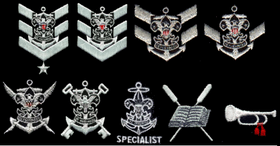
Ship Officers
Boatswain, boatswain mate, crew leader, assistant crew leader,
yeoman, purser, specialist, storekeeper, bugler
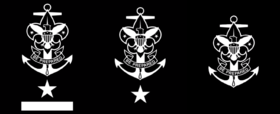
Ship Leaders
Skipper, mate, committee chair or member
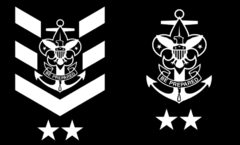
Council(Squadron) Leadership
Boatswain, Commodore and Committee
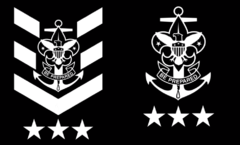
Area(Flotilla) and Region Leadership
Boatswain, Commodore and Committee
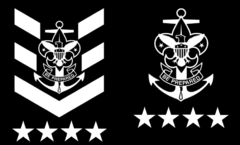
National Leadership
Boatswain, Commodore and Committee
Sea Scouts have traditionally worn US Navy style uniforms or an activity shirt.
The current edition of the Sea Scout Manual (#33239, 2012), lists and illustrates the current, approved Sea Scout uniforms. Traditional Sea Scout Uniforms (based on modified US Navy uniforms) were standardized by Commander Thomas J. Keane, a U.S. Naval Officer, who revamped Sea Scouts in the mid-1920s.
In 2012, the National Sea Scout Committee authorized the New Century Universal Uniform(NCUU). This universal uniform is the same for youth and adults as well as men and women. It is flexible enough to be used as an all purpose uniform and is authorized for wear at National Events. The uniform is made up of a dark blue "Dickies" Shirt, dark blue pants, a black ball cap or the traditional "Dixie Cup" hat, an optional dark blue neckerchief or "Tar Flap" neckerchief (youth only), a black belt, and black shoes.[4]
The traditional youth uniform resembles US Navy enlisted-style uniform: the so-called "Cracker Jack" uniforms in white or navy blue for formal and semi-formal occasions, and for all other activities. To avoid confusion with Naval personnel, changes are made to these uniforms. The center stripe on the cuffs and "tar flap" (the square collar) on the navy "Cracker Jack" uniform is removed and tar flap ornaments, known as "bugs", are sewn on over the stars on both uniforms. In addition, Sea Scout strips are worn over the right breast on all uniforms in a manner similar to the "Boy Scouts of America" strips worn on the Scouting shirts. The 'dixie cup' hat is also worn.[5]
The traditional adult uniform resembles US Navy officer-style uniform: the dress blue and summer whites (similar to the US Navy's "tropical white-long" uniform—a short-sleeve white shirt with detachable soft epaulet loops with the adults position embroidered on them, with white trousers, belt and shoes). A white combination cap is worn with blues and whites. The wearing of adult uniforms is optional for those with the Quartermaster rank, but only at the local council and unit level, as the National and Regional officers must wear the "Cracker Jack" uniform. If worn, the uniform is worn in the same manner as that of a Navy Chief Petty Officer.[5]
While still an acceptable uniform, the youth "dungaree" and adult khaki summer work uniforms have been widely replaced by the New Century Universal Uniform.
Insignia are as follows:
- All badges are white on blue for navy blues, adult khaki and dungarees, and blue on white for whites. One does not wear contrasting insignia on the uniforms.
- The local council's CSP, council strip, is worn on the left sleeve just as it is worn on other Scout uniforms.[6]
- Below the local council strip, the Ship numerals (either white or blue) are worn. Use of ship's numerals is no longer part of the 'official' uniforms, but many ships continue to wear them for tradition. Below the numerals the badge of office is worn. Adults in dress blues wear their badge of office 2 inches from the cuff of the sleeve(Quartermasters who opt for wearing the adult dress blue uniform wear the plain Sea Scout Anchor in this position). Below the badge of office is the Long Cruise patch, with segments in white and red for addition cruises (white=1 additional award, red=5 additional awards).[6]
- On the right sleeve the U.S. Flag patch is worn.[6]
- Below the flag, the Ship's emblem or standard Sea Scout emblem is worn is worn. The ship emblem, unique to each unit, has the ship's name, number, and location (city & state) on it. This replaced the unit numeral patch on the left sleeve, which was worn prior to 2003, but ship crests have been around since the 1920s. If the individual works above the Ship level, the standard Sea Scout emblem is always worn.[6]
- Above the left breast pocket, Sea Scouts and leaders can wear up to six square knots or five pin-on medals on the dress blue or white uniforms, with the badge of rank being worn on the pocket itself. No knots are supposed to be worn on the summer tan uniform, though many do. Quartermasters wearing the "Cracker Jack" uniform wear the round, blue Quartermaster emblem. The Sea Scout Advanced Leadership Training (SEAL) "double dolphins" pin is worn above the knots.[6]
- Above the right breast "pocket", the distinctive "SEA SCOUTS B.S.A." strip is worn. This strip is available on white, navy blue, khaki, and chambray blue. The nametag being worn above it. The adult Seabadge pin is worn above the nametag.[6]
- On the collar of the adult's khaki uniform, the adult wear "collar marks", showing position of office, in the same manner as that of US Navy officers.[6]
- On the shoulders of adult summer white uniform, black soft shoulder epaulet covers are worn on the shirt's epaulets. These have the position of office embroidered (or use the metal collar marks).[6]
Other notes
- Wearing of Wood Badge beads is allowed on Sea Scout uniforms. Wearing of beads is not recommended while conducting boating activities due to safety reasons.[5]
- Wearing of military style campaign ribbons and other non-BSA awards are not allowed on Sea Scout uniforms.[7] This is due to avoiding looking like U.S. Navy personnel.
- Wearing of OA Lodge flaps is only allowed on the New Century Universal Uniform.[8]
- Wearing of OA Sash is allowed at an Order of the Arrow function.
- Those that attend National Scout Jamboree or World Scout Jamboree will wear one Jamboree patch on their uniforms above the right pocket, at least during the Jamboree.
Adult insignia
The position of adult or youth leaders is indicated by insignia that uses the Sea Scout Badge (Boy Scout First Class badge superimposed on an anchor) or the Boatswain's insignia, and a combination of and stars to indicate the level.
The level of a Scouter is indicated by the stars.
- 1 star ( * ) is ship level
- 2 stars ( ** ) is council level (squadron)
- 3 stars ( *** ) is area or region level (area or flotilla and region respectively)
- 4 stars ( **** ) is National (fleet) level
With the publication of the 2012 Sea Scout Manual, the rope diamond and rope oval around the Sea Scout emblem were discontinued for the committee chairman and committee member respectively. All adult leadership above the Ship level use the standard Sea Scout Badge no matter their position. At the ship level, the Skipper is indicated by a star and bar ( *|) below the Sea Scout badge, while the mate (Skipper's assistant leaders), have just a star (*).
Advancement

The Sea Scout rank system consists of Apprentice, Ordinary, Able and Quartermaster. The first rank of Apprentice shows basic marlinspike seamanship skills, safety and basic ideals. To earn Ordinary, the Sea Scout must know the Ideals of Sea Scouting, be an active member for six months, learn specials skills relating to boats, marlinspike seamanship, piloting, communicating, swimming, safety, and cooking. In addition three of seven electives need to be completed such as, close order drill, signaling in semaphore, boxing a compass, yacht racing, sailing, ornamental ropework, and engine maintenance. For the Able rank, the Sea Scout must be able to explain and demonstrate a complete knowledge seamanship skills, earn the Lifesaving merit badge, complete a long cruise, and must and be an officer in his or her ship.
Quartermaster is the highest rank attainable by a Sea Scout and is equivalent to Eagle Scout (Boy Scouts of America). The Sea Scout must attend at least three quarters of all Ship meetings and special activities over eighteen months, demonstrate marlinspike seamanship and leadership skills, demonstrate the ability to teach Sea Scouting skills, complete a Quartermaster Leadership Service Project (community service project) and pass a council level board of review. The Quartermaster emblem is a medal consisting of the Sea Scout emblem on a ship's wheel that is suspended from a solid dark blue ribbon that is in turn suspended from a bar bearing the design of a double carrick bend knot. In 2011, 40 Sea Scouts attained the rank of Quartermaster, compared with over 51000 Eagle Scouts.[9]
Sea Scouts who earn this rank are entitled to wear a uniform similar to that of a United States Navy Chief Petty Officer (CPO), and can earn advanced rates upon enlistment into the U.S. Navy or United States Coast Guard.
Although not an actual rank, pre-Apprentice members are sometimes referred to as "cabin-boys" or "cabin-girls".
Other awards and recognitions
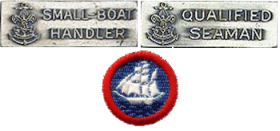
Small Boat Handler, Qualified Seaman
Long Cruise Badge
Sea Scouts currently may earn two seamanship knowledge and skill qualification recognitions: the "Qualified Seaman" and "Small Boat Handler" badges.
Sea Scouts may also obtain the boating licenses and safe boating training certifications offered at the state and local levels and are encouraged to qualify in first aid, CPR, lifesaving, SCUBA and US Sailing certifications. Ships are encouraged to affiliate with the United States Power Squadrons, enabling Sea Scouts and Scouters to obtain the USPS training.
The Long Cruise Badge may be earned by Ordinary rank and above Sea Scouts and adults who complete a two-week cruise, or a series of weekend or overnight cruises adding up to 14 days. Segments indicate subsequent awards— white for one additional award and red for five additional awards.
From June 1998 to February 2016 Sea Scouting was part of the Venturing program and Sea Scouts could earn Venturing awards. Sea Scouts are currently eligible to earn Venturing Awards through a grandfather agreement. Sea Scouts who have earned the First Class rank in Boy Scouting can work on requirements and merit badges for the rank of Eagle Scout until age 18.
Activities
As a nautical program, most ships engage in several activities in this area, such as sailing trips, scuba dives, and other boating activities. Ships also have to work on maintain their boats and equipment.
Councils with a squadron structure may hold Sea Scout regattas or rendezvous organized among local ships, usually with sailing competitions that may include ships from other councils. Several areas and regions also organize similar events. Every summer several Sea Scouts are selected to Sail aboard the USCGC Eagle. Sea Scouts also have the opportunity to qualify for the biannual William I. Koch International Sea Scout Cup, an international Sea Scouting event.
Training
Sea Scouts take specific Sea Scouting training for youth and adults.
Youth Training
![]()
There are several training opportunities available to Sea Scout youth including Quarterdeck Training, Introduction to Leadership Skills for Ships (ILSS), and Sea Scout Advanced Leadership Training (SEAL). The SEAL program is a week-long course designed teach leadership skills while underway.[10] SEAL graduates earn the double-dolphin SEAL pin. Adults who completed SEAL training as a youth or has qualified to be a SEAL course director or assistant course director may also wear the pin. Safety at Sea is a joint U.S. Coast Guard/BSA hands on training event that teaches advanced maritime skills to Sea Scout youth.
Adult Training
Sea Scout adults complete Sea Scout Adult Leader Basic Training. More advanced training courses such as Seabadge, the advanced leadership and management course for adults, and Seabadge Underway are available to Sea Scout Leaders.
See also
References
- 1 2 "Boy Scouts of America Youth Application" (PDF). Boy Scouts of America. #28-406B. Archived from the original (PDF) on April 14, 2008. Retrieved March 10, 2008.
Venturers and Sea Scouts registered in a crew or ship prior to their 21st birthday may continue as members after their 21st birthday until the crew or ship recharters or until they reach their 22nd birthday, whichever comes first.
- ↑ "Sea Scout Resolution". Sea Scouts, BSA. Boy Scouts of America. Retrieved February 10, 2016.
- ↑ Bryan Wendell. "Sea Scouts becomes its own program within the BSA". Bryan on Scouting.
- ↑ "New Century Uniform". Sea Scouts, BSA. Boy Scouts of America. Retrieved May 11, 2015.
- 1 2 3 Johnson, Cassie (2012). Sea Scout Manual, 11th Edition. Irving, TX: Boy Scouts of America. ISBN 978-0-8395-3239-2.
- 1 2 3 4 5 6 7 8 "Boy Scouts of America Guide to Insignia" (PDF). Boy Scouts of America. Retrieved March 16, 2016.
- ↑ Boy Scouts of America: Sea Scout Manual, page 115. 2002.
- ↑ "2015 National Committee Meeting". Sea Scouts, BSA Blog. Boy Scouts of America. Retrieved March 16, 2016.
- ↑ Bolton, David (May 2012). "Top Scouts". Sailing. Vol. 46 no. 8. p. 16.
- ↑ "Youth Training and Education". Boy Scouts of America. Boy Scouts of America. Retrieved March 16, 2016.
External links
- Official website
- Sea Scouts at DMOZ
- Michael Brown. "A History of Senior Scouting Programs in the BSA". Retrieved November 13, 2006.


